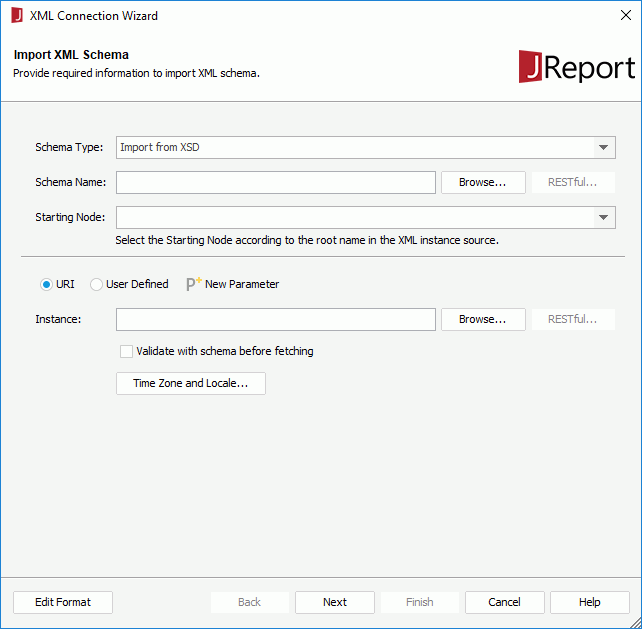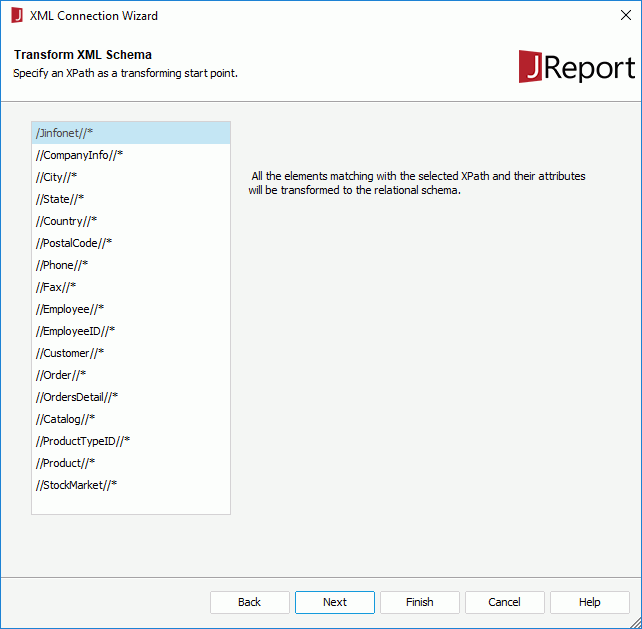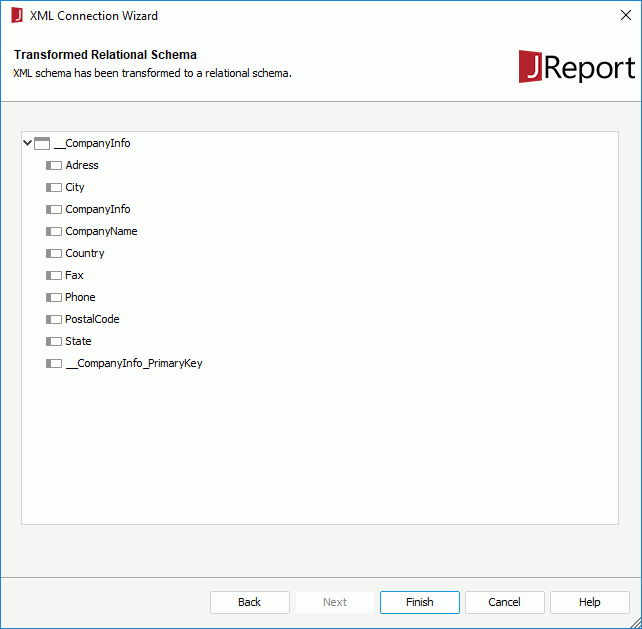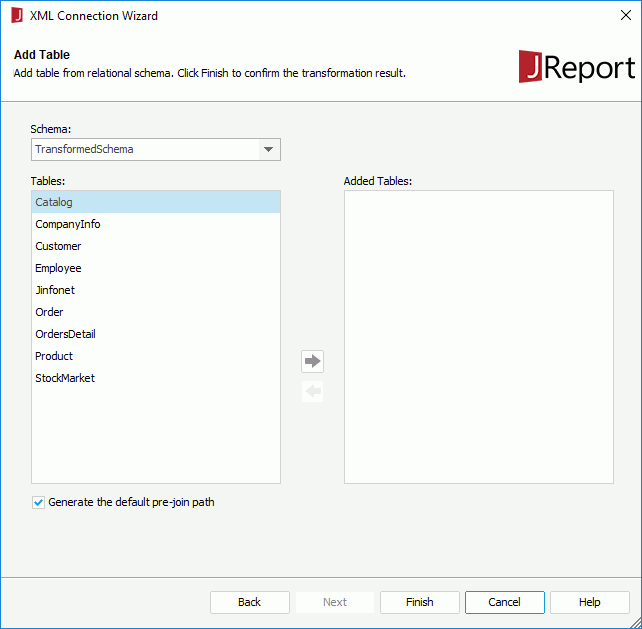XML Connection Wizard Dialog
The XML Connection Wizard helps you to get data from an XML data source by import XML schemas and transform them to relational schemas. It appears when you select XML and select OK in the New Data Source dialog, or in the Catalog Manager right-click a data source and select Add XML Connection from the shortcut menu or right-click an existing XML connection and select Edit Connection from the shortcut menu.
The wizard contains the following screens:
Back
Goes back to the previous screen.
Next
Goes to the next screen.
Finish
Finishes confirming to transform an XML schema to a relational schema.
Cancel
Does not retain changes and closes this wizard.
Help
Displays the help document about this feature.
Import XML Schema
Specifies the necessary information to import XML schema.

Schema Type
Specifies the type to import XML schema: Import from XSD or Parse from an XML Instance.
Schema Name
Specifies the schema file by selecting the Browse button or inputting the URI string directly in the text box. In the URI string, you can reference parameters and constant level formulas in the current catalog data source and the special field User Name in the format "@fieldname".
- RESTful
The button is activated when the specified URI string begins withhttp://orhttps://protocol. selecting it opens the RESTful Data Source Options dialog, in which you can define the RESTful options for the schema data.
Starting Node
Specifies the starting node, according to the root name in the XML source.
Instance
Specifies the XML instance by selecting the Browse button or input the URI string directly in the text box. It should match with the selected XSD schema. In the URI string, you can reference parameters and constant level formulas in the current catalog data source and the special field User Name in the format "@fieldname".
- RESTful
The button is activated when the specified URI string begins withhttp://orhttps://protocol. selecting it opens the RESTful Data Source Options dialog, in which you can define the RESTful options for the instance data.
Time Zone and Locale
Opens the Time Zone and Locale Options dialog to specify the default time zone and locale for the XML instance.
The following options are available only when you select Import from XSD from the Schema Type drop-down list.
- URI
Specifies to get instance data from URI. - User Defined
Specifies to get data from user defined interface.- Class Name
Specifies the full name (including package name) of the class by selecting the Browse button or inputting the class name directly in the text box. The class should be appended to the class path in the system environment. - The class implements
After filling in the Class Name field, the class name of the interface that the class implements will be displayed here. - Parameter
Specifies the parameter string for the user defined data interface. The parameter string must match the format defined in the class. In the parameter string, you can reference parameters and constant level formulas in the current catalog data source and the special field User Name in the format "@fieldname".
- Class Name
- New Parameter
Opens the New Parameter dialog to create a parameter in the current catalog data source. You can then reference the parameter to dynamically specify a URI or user defined interface that matches with the selected XSD schema at runtime. - Validate with schema before fetching
If selected, Logi JReport Designer will validate whether or not values in the XML instance is valid according to the W3C standard and the specified XSD schema. If not, a message - Invalid Value will pop up.
Edit Format
Opens the Edit Format dialog to specify the value formats of the referenced parameters and formulas.
- Name
Displays names of the parameters and formulas. - Format
Specifies the value formats of the parameters and formulas.
- OK
Accepts changes and closes the dialog. - Cancel
Does not retain changes and closes the dialog.
Refresh
Available only when you edit an existing XML connection. Once you make some change in the wizard and select the Refresh button, the XML schema information will be reloaded according to what you have changed.
Modify Schema Properties
Specifies properties of the XML schema.

Schema
Lists the corresponding schema structure of the root.  stands for elements,
stands for elements,  stands for the attributes in the XML schema and
stands for the attributes in the XML schema and  stands for the references of elements.
stands for the references of elements.
Properties
Lists all the properties of the selected elements and attributes in the schema.
- Name
Displays names of properties of the selected elements or attributes. - Value
Specifies values of properties for the selected elements or attributes.
Transform XML Schema
This screen allows you to specify an XPath as a transforming start point. All the elements matching with the selected XPath and their attributes will be transformed to the relational schema.

Transformed Relational Schema
This screen lists the transformed relational schema structure. It helps you to select Next to confirm the transformation results and go into the Add Table screen.

Add Table
Adds tables that are transformed from the relational schema to the connection. This screen is not available when you edit an existing XML connection.

Schema
Lists the schemas in the database for you to select.
Tables
Lists the tables transformed from the XML schema.
Added Tables
Lists the tables that you have added from the relational schema.

Adds the selected tables.

Removes the selected tables from the Added Tables box.
Generate the default pre-join path
Specifies whether or not to generate the default pre-join path for tables of the XML data source.
 Previous Topic
Previous Topic